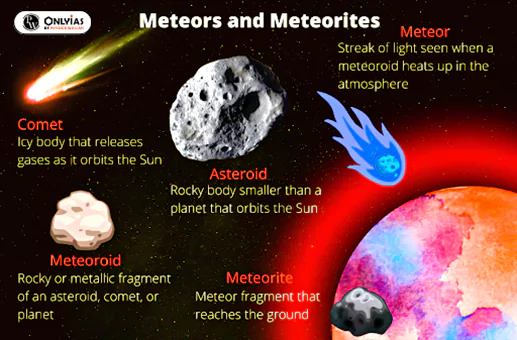Introduction: Exploring Space through Comets, Meteoroids, and More #
Comets, meteoroids, meteorites, and meteors are amazing things in space that really grab our attention. Comets are like space travelers with shiny tails that we can see at night. Meteoroids are small space rocks that sometimes come close to Earth and turn into meteors, making bright, sparkly shows in the sky. If a meteor doesn’t burn up, it becomes a meteorite, and these are like space treasures that help us learn about our solar system.
All of these things in space make the night sky fascinating and help scientists discover new things about the universe.
Comets: Cosmic Celestial Nomads with Icy Tails #
Comets are small solar bodies primarily composed of ice. They follow elliptical orbits around the Sun. They are known for their distinctive appearance and unpredictable appearances in the night sky.

- Composition: At the heart of a comet is a solid core called the nucleus, primarily composed of water ice, frozen gasses, dust, and rocky material.
- This nucleus can vary in size from a few kilometers to tens of kilometers in diameter.
- Coma: As a comet approaches the Sun, the heat causes the nucleus to release gas and dust, forming a glowing cloud around the nucleus called the coma.
- The coma can expand to many thousands of kilometers in size.
- Tails: Comets are famous for their tails, which are composed of gas and dust particles pushed away from the Sun by the solar wind and radiation pressure.
- There are two types of tails:
- Ion Tail: Composed of ionized gas (plasma) and points away from the Sun.
- It appears bluish and can be very long.
- Dust Tail: Made up of fine dust particles and follows the comet’s path, appearing white or yellowish.
- It can be curved due to the comet’s motion.
- Ion Tail: Composed of ionized gas (plasma) and points away from the Sun.
- Types of Comets Based on Origin – Understanding their Diversity
Comets exhibit diverse origins and orbital characteristics, classified as short period, long period, periodic, and non-periodic.
-
- Comets can be classified into two main types based on their origin and orbital characteristics:
- Short Period Comets
- Originates from the Kuiper Belt, a region of the solar system.
- These comets complete their orbits around the Sun in less than 200 years.
- Long Period Comets
- Originate from the Oort Cloud, a distant region of icy bodies beyond the heliopause.
- These comets have much longer orbital periods and can take thousands of years to complete one orbit.
- Periodic and Non-Periodic Comets
- Some comets, like Halley’s Comet, have predictable and periodic orbits, returning to the inner solar system at regular intervals.
- Others are non-periodic and may visit the inner solar system only once.
- Short Period Comets
- Example: Halley’s Comet is a well-known periodic comet that appears every 76 years.
- Comets can be classified into two main types based on their origin and orbital characteristics:
The Oort Cloud is a theoretical and hypothetical region of space located far beyond the outermost planets of our solar system, including the Kuiper Belt and the scattered disk.
|
Understanding Meteoroids: Celestial Particles and Hazard to Earth #
| Term | Description |
| Meteoroid |
|
| Composition |
|
| Origin |
|
| Impact on Earth |
|
| Hazards |
|
Decoding Meteorites: Survivors of Celestial Journeys and Earthly Impacts #
| Term | Description |
| Meteorite |
|
| Composition |
|
| Types |
|
| Origin |
|
| Impact on Earth |
|
| Examples |
|
Glimpsing Meteors: Understanding Celestial Light Shows #
A meteor is a bright streak of light produced when a meteoroid, a small celestial object, enters Earth’s atmosphere.
- Appearance: Meteors are often referred to as “shooting stars” because of their rapid and luminous appearance.
- Cause: Meteors are caused by the friction and heating of the meteoroid as it rapidly descends through Earth’s atmosphere.
- Brightness: Meteors can vary in brightness, with some being faint and others exceptionally bright, known as fireballs or bolides.
- Duration: A typical meteor streak lasts only a few seconds, but they are memorable and visible from the ground.
- Abundance: Meteors are quite common, and numerous meteors can be seen during meteor showers, which occur when the Earth passes through the debris left by a comet.
- Safety: Meteors do not pose any danger to Earth as they are usually small and disintegrate in the atmosphere.
- Scientific Study: Meteors are studied by scientists to better understand the composition of meteoroids and the dynamics of Earth’s atmosphere.
Understanding the Cosmic Trio: Meteoroids, Meteors, and Meteorites #
The distinction among a meteor, meteorite, and meteoroid primarily depends on where these objects are located:
|
Fireballs in the Sky: Exploring Brilliant Celestial Phenomena #
A fireball is an exceptionally bright and luminous meteor, often much brighter than the average meteor.
- Cause: They are produced when a relatively large meteoroid, typically several centimeters to meters in size, enters Earth’s atmosphere and rapidly heats up due to atmospheric friction.
- Duration: They can last longer than regular meteors, sometimes visible for several seconds, which allows more people to witness them.
- Frequency: While less common than ordinary meteors, fireballs are still regularly observed around the world.
- Scientific Value: They are of great interest to scientists as they can provide information about the composition, size, and speed of the meteoroids that produce them, helping to better understand the population of space objects in our solar system.
- Impact: Fireballs typically disintegrate high in the atmosphere and do not pose a threat to the surface.
Conclusion: #
- In the vastness of space, comets, meteoroids, meteorites, and meteors provide inspiring celestial displays, offering valuable insights into the workings of our universe and posing minimal danger to Earth.
Previous Year Question (Prelims) #
Q. A meteor is:(UPSC CSE 1995)
- a rapidly moving star
- a piece of matter which has entered the earth’s atmosphere from outer space
- part of a constellation
- a comet without a tail
Ans: b

 GS Foundation
GS Foundation Crash Course
Crash Course Combo
Combo Optional Courses
Optional Courses Degree Program
Degree Program












